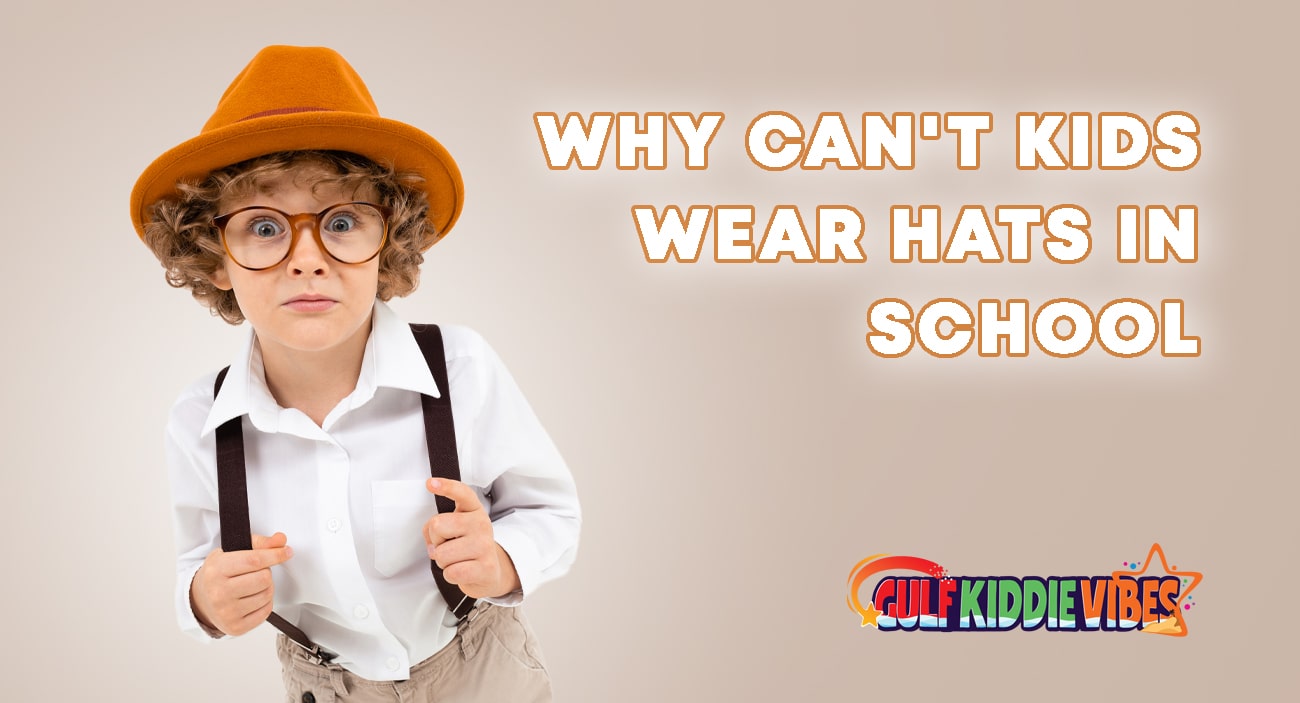
Why Can’t Kids Wear Hats in School? Rules and Reasons in Depth
Ever wonder why kids can’t wear hats in school? The rule stems from security concerns, preventing cheating, and traditional manners. While some schools allow exemptions for religious or medical reasons, others enforce strict no-hat policies. Is the ban outdated, or does it help maintain focus? Discover the surprising reasons behind this policy and whether it’s time for a change.
Table of Contents
Since the early 20th century, schools have stopped allowing students to wear hats and other accessories in school. But why can’t kids wear hats in school? Several reasons have been cited, some of them being to maintain discipline, safety, respect, and stop cheating.
I will cover all of these reasons, along with some exceptions, both sides of the debate, and what either parents or students can do about it. This is an interesting debate where both sides have solid arguments. Knowing both sides will help both parents and kids make better decisions about school attire and what’s allowed or not.
Historical Context of School Dress Codes

Before the 1900s, schools were looser both in the US and elsewhere. This may have been because schools were a luxury, and only the elites had access to them. But from the early 20th century, schools started to implement the no-hats policy. The policy banned other items, such as jewelry, as well, but hats were at the top of the list.
The reasoning behind this was that schools were being opened to all kids from all backgrounds. As such, schools needed to implement rules that would ensure everyone looked the same in their uniforms. Uniformity and discipline were to be maintained, which is why distracting clothing, extreme hairstyles, and, often, no hats were allowed.
In recent years, many schools in the US, particularly public schools, have started to allow more diversity in students’ appearances. Simple jewelry, dyed hair, and such have become more common, but hats remain banned.
You have to understand that kids can wear hats in schools in other parts of the world. In Australia, hats are encouraged because of the heat and sun. So why does the “no hats indoors” rule still exist in the USA?
Common Reasons Schools Ban Hats
To understand why can’t kids wear hats in school in the US, we need to look at the reasons schools tell us about it. Some of these reasons have validity, while others will seem weird to both you and me.
1. Maintaining Discipline and Uniformity
A major reason kids can’t wear hats in school is that schools think that hats can disrupt and break uniformity. Teachers believe that kids, especially young ones, will play with their hats in class and not pay attention to the lesson. Also, teachers think that older kids will hide their earbuds and listen or talk with others in class.
Hats can be expensive, and if kids wear expensive ones to school, it might make others self-conscious or jealous. That is a big concern for schools because they are supposed to be places where everyone is supposed to be equal.
2. Safety and Identification Concerns
Another concern for schools and why they banned kids from wearing hats is that they can be used to hide kids’ identities. With so much crime happening in and around schools in the US, this is a valid concern. Hats can hide faces from the camera, and this can make it easier for kids to commit crimes in and around schools.
Public schools in the USA have a big problem with gangs in schools. Typically, these gangs will have their members tattoo or wear signs that symbolize them. Currently, in the US, in 2019, it has been found around 9 percent of public school students related to criminal gangs. Hats are a part of the problem because they are either used to hide these gang signs or display them to everyone. This is why most public schools are attempting to ban the wearing of hats in school.
3. Respect and Etiquette
Schools are meant to be places of learning, and as such, kids, meaning students, are meant to show respect to their fellow students and their teachers or staff. Kind of seems old-school, right? Because it is, and it’s tied to the old phrase “take your hats off indoors.”
In addition, there are traditions in many cultures where you aren’t supposed to be wearing your hats indoors because it’s a sign of disrespect. So, you see why some schools might not want to allow kids to wear hats in school. This is why many teachers and schools that tend to be old-school will enforce the rule that kids can’t wear hats or even certain accessories while on school grounds.
4. Preventing Concealment of Cheating
Another old and new school, pun intended, problem teachers face when kids wear hats in school is cheating. Hats have been used for cheating in tests for a long time because they act as a concealment device. Kids have been known and seen wearing hats to hide cheat sheets during test times.
Recently, with wireless earbuds, kids have been known to hide them under their hats and hoodies. They use the earbuds to listen to answers from their tests, and teachers have a hard time noticing it in a test room. This is why teachers have asked schools to ban hats in classes.
5. Hygiene and Health Reasons
This is a unique reason why kids can’t wear hats in school. According to some school medical staff, hats are apparently a health problem. A major health problem schools deal with for younger kids is head lice. The problem can become major when hats are shared amongst friends.
Parents like me tend to want their kids to wear hats for added sun protection while they are outdoors. But schools that ban hats make kids take them off the moment they are on school grounds. I will share more about this debate later in the article.
Exceptions to the No-Hat Rule

So we went over why kids can’t wear hats in school anymore, but you should know that there are some exceptions, like always. Let’s go over the most common exceptions to the no-hat-in-school rule. They are:
Religious and cultural headwear
This one is obvious to us all, right? There are certain cultures in America and religions as well where students must wear certain headgear. Schools must allow them because not doing so will cause the school to fail to meet certain laws and regulations under the First Amendment and federal anti-discrimination laws.
Some of these headgear or “hats” include:
- Hijabs (Muslim headscarves)
- Yarmulkes/Kippahs (Jewish skullcaps)
- Turbans (worn by Sikh students)
- Rasta caps (for Rastafarian students)
There have been cases where schools didn’t allow these “hats,” which resulted in some major backlash for those schools. These schools also faced legal actions, such as class-action lawsuits, due to classifying these headgear as “fashion” hats. Can you believe it?
Medical and health-related exemptions
Students undergoing certain medical or health-related conditions meet the requirements to openly wear hats in school. These conditions include and aren’t limited to:
- Alopecia or hair loss (due to chemotherapy or autoimmune disorders)
- Photosensitivity (extreme sun sensitivity requiring wide-brimmed hats)
- Post-surgical head protection
As always, there have been cases where schools in the US didn’t allow hats. The school’s reasoning for the rejection is that a doctor’s note hadn’t been provided even though the medical files were more than enough.
Whether or not outdoor safety
During certain times of the year, it becomes essential that kids wear hats to and in school. For example, kids can and should wear wide-brimmed hats during PE and school trips during summertime. This is for protection from the sun. During wintertime, beanies and woolen hats are crucial for protection from the cold.
Thankfully, if you live in one of the hotter or colder states in the US, you don’t have to worry too much. Public and private schools in these states have relaxed rules about kids wearing hats because of the harsher weather.
Special school events
Why can’t kids wear hats in school during certain special school events? There is no reason whatsoever. Events like spirit week, sports events, and school performances demand that kids wear hats. And some strict schools allow them when their cases have been made to the school board.
So, there are some cases when hats are allowed to be worn in school, but these are in the minority. However, as I have told you, if you can make a strong case for their allowance, some schools will hear you out.
The Debate: Should Kids Be Allowed to Wear Hats?

The question of why kids can’t wear hats in school has been a long-standing and debated topic amongst parents, students, teachers, and school administrators. There have been both good and bad arguments for and against it from all sides. Today, I will go over both to help you find your side in this debate.
Arguments Supporting Hat Bans
Three major arguments have supported the no-hat ban in school, mainly from the teachers and school admins. These arguments are:
Reducing distraction in class
According to teachers in many US schools, wearing hats is very distracting in classes. Apparently, hats make it more likely for students to fidget, which in turn makes them more distracted from the lesson being taught. Teachers have found students to adjust their caps or play with their hats’ brims in class instead of paying attention.
Hats also prevent teachers from fully seeing their students’ expressions when they sit far away, which prevents them from gauging how engaged they are with the class. Finally, students, both young and old, have arguments with their teachers when they see others wearing something while they are banned from wearing hats.
Preventing security risks
Another sad but true argument made by teachers and schools in the US is that hats present a security risk to the institute. Hoods and hats are commonly seen worn by students before or after they perform a criminal act. They use hoods and hats to hide their identities from security officers and cameras.
The hats also help students hide their wireless earbuds, which they wear during tests to help them cheat. Hats can also hide cheat sheets with answers, which is a problem for teachers as well.
Certain colors or designed hats can symbolize a student’s connection with a gang, which is a major security risk for schools. In the US, many of the students in public schools have connections to gangs. And many of these students wear hats with either gang colors or symbols to school to show their affiliation.
Upholding tradition and respect
This is a very weak argument for why kids can’t wear hats in school, in my opinion. Schools ban hats because they believe that hats break up the uniformity schools are meant to have. Even though we are in the 21st century, schools still follow the old 19th—or 20th-century thinking.
These schools wish to follow the historical etiquette of removing hats as a sign of respect and make students appear more professional by following old-school dress codes.
Arguments Against Hat Bans
Now, let’s go over arguments against why kids shouldn’t wear hats in school. There are also three main major arguments against the no-hat bans. They are:
Hats encouraging self-expression
Parents and students argue against the no-hat ban because hats are an excellent means for kids to express themselves. Nowadays, schools are supposed to help students show their personality and express themselves in their unique ways.
Allowing hats in school can help some kids with their self-image issues. Some kids, especially teens, have issues with their hair and appearance, which they use hats to hide. By not allowing hats in schools, the school is causing anxiety and other mental problems for these students.
Hats helping with practical needs
There are cases where students need to wear hats for practical reasons. For example, during the summer months, I have my kids wear hats to and from school and at any time they are outside during PE. This is a practical argument for why kids need to wear hats in school.
Additionally, if a kid has some medical operation or issue, they should also be allowed to wear hats in school.
Inconsistent enforcement
If hoodies are allowed in school, what’s wrong with hats in school as well. Hoods do better, or worse, depending on the job of hiding faces, expressions, earbuds, and such from teachers than hats. They are allowed in all schools, but hats aren’t. In my opinion, that’s a very inconsistent enforcement of rules.
How Schools Enforce No-Hat Policies

Now that you have a clearer picture of why kids can’t wear hats in school, it’s time parents learned how schools enforce this policy. Knowing what schools will do will help parents help their kids either get their hats back or ask for a ruling.
There are two main ways schools enforce the no-hate rule: detention or confiscation of the hat. Both ways seem extreme to me unless the hat causes major problems. But some teachers enforce the rule very strictly, even in justified cases, so parents like you and I must get involved.
What Parents and Students Can Do
If your kids’ hats are confiscated or they are given detention for wearing hats to school, then parents are supposed to question it. Unless the reasoning is something like your kids cheated on a test while wearing hats that hid earbuds, then the confiscation or detention isn’t valid.
So, what can you do? You can either request an exception or start a discussion about the rules being changed. But whatever you do, you first need to check the school rulebook to know what the school can or can’t do. This will ensure you can have a proper conversation while knowing all the facts.
Alternatives to Strict No-Hat Policies
Instead of just banning kids from wearing hats at any time in school, the school can adjust its policies to find a middle ground. There are some alternatives to this no-hat policy that will help and not hinder the kids learning in school. Here they are:
The “Hats On Outside, Hats Off Inside” Rule
The best suggestion I have heard and seen is this rule: Kids can wear hats in school, but in certain areas only. This allows kids to wear their hats and come to school with no issues. Certain areas will depend on the school, but the hallways, cafeterias, playgrounds, and outdoor spaces are accepted. Classrooms, labs, and assembly areas aren’t allowed, and they do make sense.
Clear Medical/Religious Accommodations
There are exceptions for kids with medical or religious reasons for wearing hats or headgear. These kids have all the rights to wear hats as they meet either the First Amendment or medical exceptions.
To ensure no arguments arise about why students are being allowed to wear hats, badges/stickers may be created to show approval. Publicizing these accommodations reduces the stigma for students who need them.
Student-Created Dress Codes
Schools should do what they can to be as progressive as their students, as that shows that schools are willing to make adjustments. A way to be such would be to have town hall discussions and run pilot programs related to dress codes. An Oregon high school revised its code after students demonstrated how hats helped with anxiety.
Frequently Asked Questions (FAQs)
1. Why do some schools allow hats while others don’t?
No – federal laws like the First Amendment and ADA require accommodations for religious and medical needs. Schools must demonstrate a compelling safety reason to deny these exceptions.
2. Can students wear hats for religious reasons?
Yes, private institutions aren’t bound by the same constitutional restrictions and generally have broader authority to set dress codes, including absolute hat bans.
3. What if a student needs a hat for medical reasons?
Through organized efforts like school board petitions, presenting research on positive outcomes in districts with relaxed policies, and demonstrating responsible hat use during trial periods.
4. Are there any benefits to allowing hats in school?
Studies suggest girls’ fashion hats like berets face stricter enforcement than boys’ baseball caps, potentially reflecting unconscious bias in dress code applications.
Conclusion
There are both good and bad reasons why kids can’t wear hats in school. Reasons such as showing respect, discipline, and uniformity aren’t accurate anymore, but preventing cheating, violence, and gang affiliation does make sense. But there are ways schools can implement their hat policies, and outright banning them isn’t helping anyone. Hats help kids with issues about appearance, self-expression, and the need to meet religious or medical needs.
Therefore, I suggest that parents and students discuss the policy with the school and find ways to adapt it for the 21st century. Allowing for exceptions, creating a no-hats indoors but outdoors policy, and adjusting the dress code are some good alternatives.






